Zoonotic infections are a group of diseases that are widespread in the human population. Infection can occur not only from wild animals, but also from domestic and stray cats, dogs, large and small ruminants, poultry. These diseases cause damage to human vital organs and, in some cases, are fatal.
Record content:
- 1 What are zoonotic infections?
- 2 Causes and risk factors
- 3 Ways of transmission of zoonotic infections
- 4 Prevalence of zoonotic diseases
-
5 The most common infections
- 5.1 Salmonellosis
- 5.2 Brucellosis
- 5.3 Echinococcosis
- 5.4 Hemorrhagic nephrosonephritis ("mouse fever")
- 5.5 Tick-borne encephalitis
- 5.6 Rabies
- 5.7 Ornithosis
-
6 Symptoms and diagnostic methods
- 6.1 Salmonellosis
- 6.2 Tick-borne encephalitis
- 6.3 Brucellosis
- 6.4 Echinococcosis
- 6.5 Mouse Fever
- 6.6 Rabies
- 6.7 Ornithosis
-
7 Treatment of zoonotic infections
- 7.1 Salmonellosis
- 7.2 Tick-borne encephalitis
- 7.3 Brucellosis
- 7.4 Echinococcosis
- 7.5 Mouse Fever
- 7.6 Rabies
- 7.7 Ornithosis
- 8 Possible complications and consequences
- 9 Zoonotic Infection Videos
What are zoonotic infections?
Zoonotic infections are a number of diseases of a bacterial, viral, fungal, parasitic nature, the natural reservoir of which is certain species of animals. Pathogens infect humans, but cannot be actively transmitted to other people, since their body is a biological dead end in the evolution of the parasite.

There are exceptions to this rule. For example, a high degree of contagiousness (infectiousness) is characteristic of plague, yellow fever and some other infections. In certain situations, a sick person can become a source of illness for other people.
Under natural conditions, the preservation and reproduction of the pathogen occurs in the body of domestic or wild animals. Most infections in humans are associated with zoonotic diseases (about 60% of the total).
Causes and risk factors
The cause of such diseases is direct contact with a sick animal (or carrier), or with the products of its secretions, wool, the use of contaminated meat and other products.
Risk factors include:
- living in rural areas and in regions with a high prevalence of infection;
- non-compliance with sanitary standards (eating with unwashed hands, lack of sanitary control over pets and their timely vaccination);
- eating meat of wild animals;
- certain types of activities - hunting, fishing, cutting meat, dressing skins, working in the food, leather industry; logging, geodetic research, development of new territories;
- insufficient heat treatment of food;
- the presence of pets;
- improper disposal of animal waste (animal carcasses);
- an increase in the population of wild animals that are a reservoir for this pathogen.
Ways of transmission of zoonotic infections
Zoonotic infections are diseases that originate from many animals. The routes of transmission can be different - from direct contact (for rabies, anthrax) to contamination through a contaminated environment (for example, tuberculosis pathogens can persist in the soil up to 4 years).
With salmonellosis, infection can occur from any egg-laying animals, livestock, poultry, cats, dogs, mice, fish, shellfish.
Most often, the pathogen is transmitted through the consumption of meat that was infected during the life of the animal or posthumously, after cutting the carcass, as well as eggs, dairy products, and powdered milk. In more rare cases, the bacterium can be carried in by hand if it comes into contact with the conjunctiva of the eyes.
For other infections, there may be more characteristic routes of infection, for example, tick-borne encephalitis - through insect bites. However, in this case, other ways of infection are also possible (through the use of dairy products from sick goats and cows).
Prevalence of zoonotic diseases
Since at least 900 million people currently live in rural areas. people, the prevalence of zoonotic infections is very high. So, from rabies, according to the World Health Organization, about 55 thousand die annually. people around the world.
This disease is widespread on all continents, and the main share in the structure of the incidence occurs in the countries of America (42%).
When slaughtering livestock, echinococcosis is detected in 12-17% of animals, and the incidence in Russia is about 500 cases per year. The prevalence of brucellosis, in which multiple organ damage occurs, in Mediterranean countries is 50 thousand. person per year.
New infections diagnosed in recent years, such as SARS, avian influenza, COVD-19 coronavirus, clearly show that zoonotic diseases can become epidemic in the international level.
The most common infections
Common zoonotic diseases include:
- salmonellosis;
- tick-borne encephalitis;
- brucellosis;
- echinococcosis;
- hemorrhagic nephrosonephritis ("mouse fever");
- rabies;
- psittacosis.


Less common diseases such as:
- toxoplasmosis;
- tularemia;
- anthrax;
- leptospirosis;
- Q fever;
- tuberculosis;
- actinomycosis;
- foot and mouth disease;
- teniidosis;
- trichinosis;
- glanders;
- scabies;
- plague;
- rickettsiosis;
- sodoku;
- yellow fever.
Salmonellosis
In salmonellosis, the digestive tract is mainly affected. The causative agent is the bacterium Salmonella. Eggs and poultry meat are the most common sources of infection. Bacteria can persist in frozen and dried foods for up to 10 months, but they quickly die when boiled.
The incubation period after infection is most often 6-24 hours, sometimes up to 3 days. Once in the gastrointestinal tract, salmonella produce toxins that lead to the development of persistent diarrhea and intoxication of the body. Immunity to this infection is short-lived, so re-infection is possible.
Zoonotic infections are diseases that in most cases can be mild or severe; some patients are carriers of bacteria. The same applies to salmonellosis. In mild cases, there is a slight indigestion, and in severe cases, general intoxication of the body, myocardial infarction, and brain damage.
Brucellosis
Brucellosis pathogens are brucella bacteria, which are common in domestic and (less commonly) wild animals. Several biotypes are distinguished, the owners of which are sheep, goats and chickens; cattle; pigs and hares; reindeer; dogs.
The disease is most common among workers in the livestock industry and meat processing plants, as well as among those who process leather and wool. This infection is not transmitted from person to person.
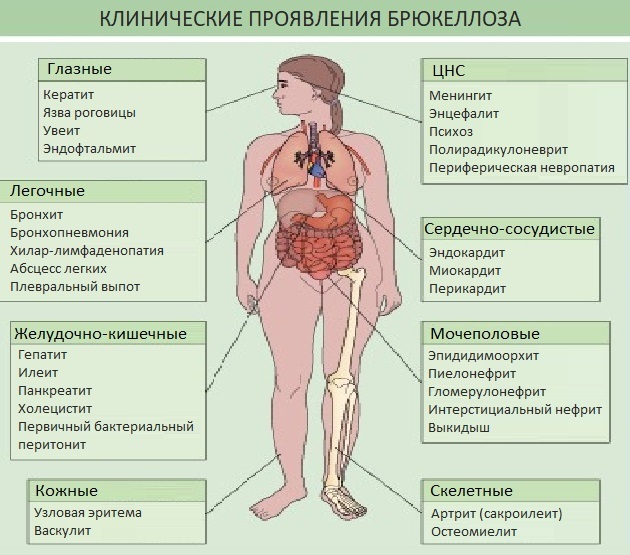
Infection can occur in many ways:
- through the skin;
- through the mucous membranes of the nose, eyes, mouth;
- when consuming milk and dairy products (they pose the greatest danger);
- aerogenic way (haircut and collection of wool, cleaning of premises, caring for animals).
The disease is characterized by multiple organ damage. The incubation period lasts an average of 7-10 days. In the absence of antibiotic treatment, bacteria can persist in the human body for up to 2 years. When boiled, they die immediately. In sheep wool, pathogens can persist for 4 months. Immunity is formed unstable, after 3-5 years re-infection is possible.
Echinococcosis
Echinococcosis is a parasitic zoonotic disease common in cattle, small ruminants and dogs. A sick animal can spread the infection for 2-3 years.
Infection with helminths most often occurs through eating meat or through contaminated hands. From the gastrointestinal tract, the worm enters the circulatory and lymphatic systems. In the liver, the parasite enters the larval stage, with the formation of echinococcal cysts.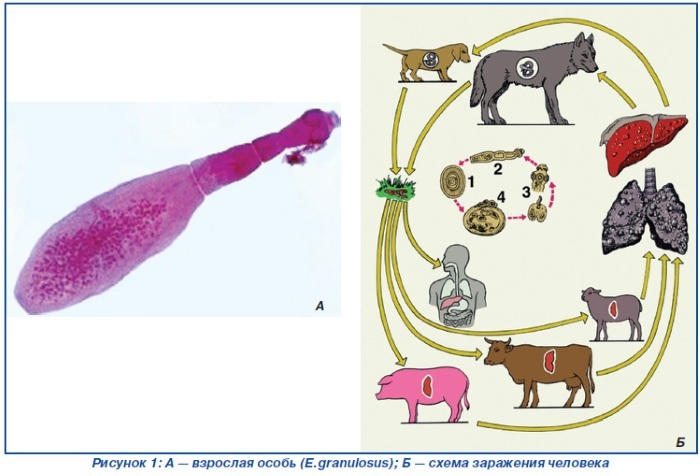
Also, in a third of patients, the lungs are affected, in more rare cases - muscles, kidneys, brain, spleen and other organs. The rupture of the cyst can be accompanied by anaphylactic shock and lead to the death of the patient.
Hemorrhagic nephrosonephritis ("mouse fever")
Zoonotic infections can also be of a viral nature. These include hemorrhagic nephrosonephritis. This is a viral disease, accompanied by severe kidney damage and the development of kidney failure. The virus is spread by mice, hamsters, rats and other rodents.
In total, there are more than 60 animals that can be carriers. Infection most often occurs when working in the garden, in barns and sheds; during hunting, fishing, picking berries and mushrooms due to air entering the upper respiratory tract with the causative agent of the disease.
The virus causes inflammation of the artery walls, which leads to impaired blood microcirculation and the development of multiple organ failure. The kidneys are most affected, the liver, pancreas, gastrointestinal tract, and the central nervous system are also affected.
Tick-borne encephalitis
Tick-borne encephalitis is a viral disease that is dangerous because it affects the brain and spinal cord. After the penetration of the virus through the skin or gastrointestinal mucosa, it spreads throughout the body. The brain is a hotbed of long-term reproduction of the virus.
The chronic form of the disease can be observed for many years and even all life. The causative agent is able to maintain viability for a long time at low temperatures; when boiled, it dies after 2 minutes. The virus leads to the rapid development of inflammatory processes in the nervous system.
In nature, 14 species of ticks are carriers of the virus. The infection is not transmitted from person to person. But, since ticks parasitize on many species of wild and domestic animals, the prevalence of this disease is quite high. In Siberia, the number of ticks in some regions reaches 40-50 pieces. for 1 km of the walking route. The incubation period is up to 35 days, on average 7-12 days.
The peak incidence occurs in the spring and late summer, when female ticks are saturated with blood for reproduction. There are several types of tick-borne encephalitis, the most mild is the western one. After a disease, persistent immunity is developed.
Rabies
Rabies, like "mouse fever", refers to viral infections. It can affect all types of warm-blooded vertebrates. The disease is mainly transmitted by contact, through the bites of infected individuals.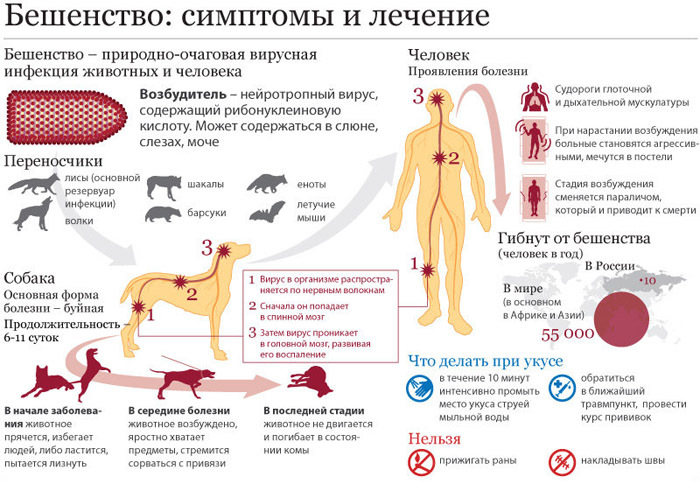
For city dwellers, the greatest danger is posed by stray cats, dogs, and house mice. From wild animals, infection most often occurs from foxes, raccoons, polar foxes, wolves, badgers, ferrets, martens. In some cases, the animal may look healthy, but the virus is present in its saliva.
After entering through damaged skin, the virus enters the peripheral nerves and then into the brain, causing meningoencephalitis. From the brain, it migrates in the opposite direction and affects other organs. The death of patients occurs as a result of damage to the respiratory and vasomotor centers in the brain.
Ornithosis
The main distributors of ornithosis are domestic and wild birds (more than 140 species). Most often, infection occurs from ducks, turkeys, pigeons and budgerigars. The causative agent belongs to the genus Chlamydia, which are intracellular parasites. It is excreted along with the nasal secretions of birds and their feces. The main route of infection is airborne and airborne dust.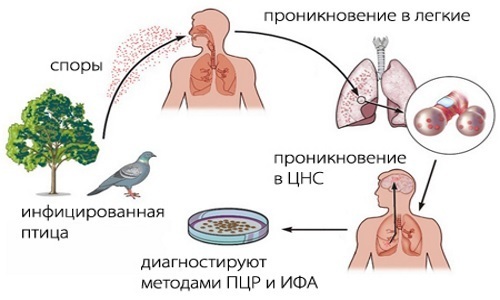
With this disease, the upper respiratory tract is first affected, then the other organs are infected through the bloodstream, where the virus can persist for a long time.
Symptoms and diagnostic methods
Symptoms and diagnostics for the most common zoonoses are described below. Many of them are nonspecific, that is, they can occur in other diseases. Therefore, it is necessary to carry out diagnostic (instrumental and laboratory) studies.
Salmonellosis
The most characteristic signs of salmonellosis are:
- diarrhea;
- nausea, vomiting;
- abdominal pain;
- flatulence;
- greenish, watery and foul-smelling stools ("swamp ooze");
- an increase in body temperature up to 38-39 ° С;
- fever for 1 to 7 days;
- chills;
- headache.
To diagnose the disease, methods such as bacteriological examination of feces, vomit are used; with severe fever - blood culture, detection of antibodies by ELISA.
Tick-borne encephalitis
The symptoms of tick-borne encephalitis are:
- chills;
- severe headache, dizziness;
- nausea, vomiting;
- an increase in body temperature up to 39 ° C;
- pain in the cervical and spinal muscles, in the lower back, limbs;
- general weakness, impaired motor activity;
- drops in blood pressure;
- short-term diarrhea;
- in severe cases - paralysis, loss of consciousness, delirium, convulsions, epileptic seizures.

The following methods are used to detect this disease:
- enzyme immunoassay (ELISA);
- PCR;
- study of cerebrospinal fluid;
- EEG, MRI and CT of the brain.
Brucellosis
In the acute course of brucellosis, the following are noted:
- feverish condition;
- inflammation of the lymph nodes;
- chills;
- excessive sweating;
- drop in blood pressure;
- headache;
- enlargement of the liver and spleen.
In severe cases, delirium, meningitis, inflammation of the heart muscle, testicles, epididymis in men develop. With the latent form of the disease, patients experience general malaise, weakness, muscle and joint pain, and worsening sleep. To determine the pathogen, methods such as microscopy of biomaterials, serological methods (ELISA, RA, RNGA, ELISA, RNGA) are used.
Echinococcosis
With liver damage in patients with echinococcosis, there are dull pains in the right hypochondrium, a disorder digestion, general weakness and fatigue, an increase in body temperature to 37-38 ° C, allergic skin reactions.
To diagnose the disease, serological methods (RNGA, RLA, ELISA), ultrasound and CT are currently used to identify echinococcal cysts.
Mouse Fever
The symptoms of mouse fever are:
- high body temperature (up to 41 ° C);
- nausea, vomiting;
- deterioration in visual acuity;
- severe headache and muscle pain;
- general exhaustion;
- pain in the eyes when they move;
- rash on the oral mucosa, armpits, chest, neck, face;
- subcutaneous hemorrhage;
- reduction in the amount of urine excreted.
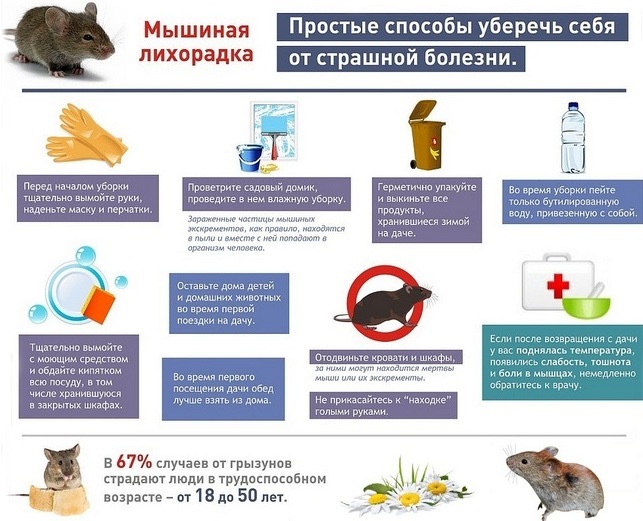
For accurate diagnosis of the disease, serological research methods are used (RNIF, ELISA, RIA).
Rabies
Signs of rabies are as follows:
- fever;
- increased sensitivity to light and sound;
- insomnia, irritability;
- hallucinations, nightmares at night;
- in the acute period - aggressiveness, agitation, convulsions, muscle spasms, hydrophobia;
- with an increase in signs of meningoencephalitis - salivation, tachycardia, decreased tone of the facial muscles;
- at the last stage - an imaginary improvement in the condition, paralysis of the tongue, arms, legs, face and death.
Zoonotic infections are dangerous diseases that are fatal in many cases. So, in case of rabies in the absence of artificial ventilation, half of the patients die on the fourth day, and after 20 days - all patients.
The diagnosis can be established by clinical signs, as well as by a blood test (RIF, RNIF).
Ornithosis
The manifestation of the acute form of the disease is as follows:
- an increase in body temperature up to 39-40 ° С;
- headache, muscle, joint pain;
- excessive sweating;
- dry cough (2-4 days);
- chest pain with the development of pneumonia;
- loss of appetite, vomiting;
- gray coating on the tongue;
- diarrhea or constipation;
- enlargement of the liver and spleen (after 7 days from the onset of the disease).
Serological methods (complement fixation test) are most often used to diagnose the disease.
Treatment of zoonotic infections
Treatment for zoonotic infections depends on the type of disease.
Salmonellosis
For salmonellosis, the following treatment methods are used:
- Antibiotics for suppressing bacteria in the gastrointestinal tract - Ciprofloxacin (0.5 g 2 times a day, 7-10 days), Ceftriaxone (2 g intramuscularly or intravenously, 7-10 days).
- Enterosorbents for removing toxins - Polysorb (daily dose: 0.1-0.2 g per 1 kg of body weight; it is divided into 3-4 doses), Enterosgel (1 tbsp. l. 3 times a day).
- Antispasmodics to reduce abdominal pain (No-shpa, 1-2 tablets 2-3 times a day).
- Means for reducing intestinal motility, antidiarrheal drugs - Loperamide, Smecta.
- Enzymes to improve the digestion process - Pancreatin, Creon.
- Probiotics - Bifidumbacterin, Bificol.
- When carriage of Salmonella - Salmonella bacteriophage (50 ml 3 times a day, 5-7 days).
- Rehydration drugs - Rehydron, Citraglucosolan (they are taken orally); Trisol, Quartasol, Acesol (intravenous).
With a mild course of the disease, it is enough to lavage the stomach and take a large amount of drink.
Tick-borne encephalitis
For the treatment of tick-borne encephalitis, the following agents are used:
- as an emergency prevention of a disease after an insect bite - human immunoglobulin against tick-borne encephalitis;
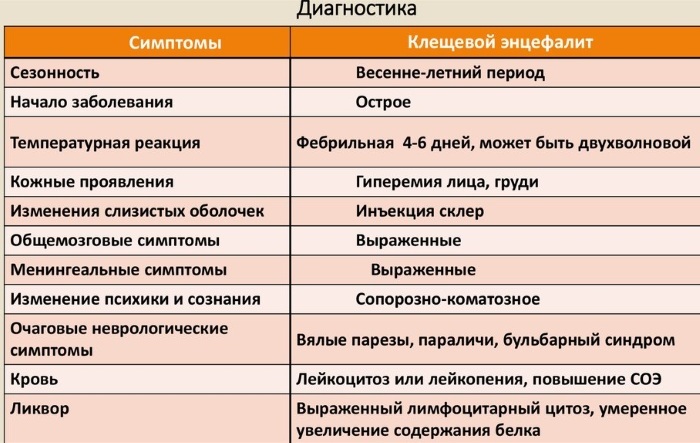
- when symptoms of the disease occur - anti-mite immune plasma, Interferon alfa2a, Meglumine acridone acetate, Ribavirin;
- to reduce the symptoms of fever and pain relief - Ketoprofen, Paracetamol, Diclofenac, Metamizole sodium;
- to eliminate seizures - Diazepam, Carbamazepine;
- neuroprotective agents - Choline alfoscerate, Piracetam, Vinpocetine, Glycine, Citicoline, Ascorbic acid, Thiamine chloride;
- with cerebral edema - Mannitol, Furosemide, Acetozolamide, Prednisolone, Dexamethasone.
This disease is treated in a hospital.
Brucellosis
Treating brucellosis presents certain challenges. Brucella quickly develop antibiotic resistance.
Of the antibacterial agents, the following are used:
- drugs of choice - Rifampicin (600-900 mg daily), Doxycycline (200 mg each) for at least 6 weeks;
- alternative agents - Tetracycline + Rifampicin, Co-trimoxazole, Tetracycline + fluoroquinolones (Ciprofloxacin, Ofloxacin) or Tetracycline + aminoglycosides (Gentamicin, Tobramycin);
- immunostimulants - Imunofan, Azoximer bromide, Recombinant human interleukin;
- to reduce fever and pain - Ketoprofen, Paracetamol, Diclofenac;
- neuroprotective drugs described in the treatment of tick-borne encephalitis.
Echinococcosis
Conservative treatment of echinococcosis is currently carried out with the drug Albendazole. However, the most effective method is surgical removal of the cysts. The operation is performed under general anesthesia.
Surgical intervention to remove cysts includes several stages:
- Checking the abdominal organs.
- Identification of cysts with parasites.
- Removal of the cyst with a closed (the most preferable method) or an open method.
- Antiparasitic treatment of the capsule.
- Elimination of fistulas.
- Drainage (installation of drainage tubes).
Mouse Fever
There are no specific treatments for this disease. Currently, studies are underway on the effectiveness of the antiviral drugs Ribavirin and Ribamidil.
Specific and complex immunoglobulins, interferons (Leukinferon, Reaferon, Viferon) are also used as auxiliary agents. Antiviral treatment is effective in the first 3-5 days.
The therapy is carried out in a hospital, in a comprehensive manner. It is aimed at eliminating the main syndromes - intoxication, hemorrhagic syndrome, renal failure and other complications.
Rabies
There is no specific therapy for rabies. The most effective way is emergency prevention of the disease through vaccination and active washing of the wound. 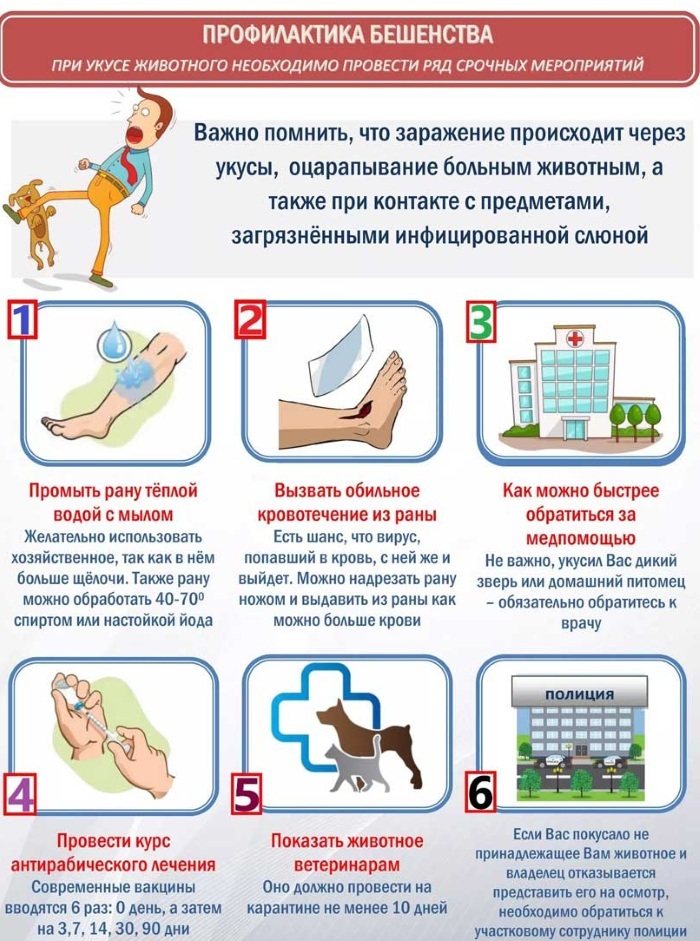 If the patient has already developed clinical signs, then symptomatic treatment in the hospital is carried out (sedatives, drug sleep, infusion therapy).
If the patient has already developed clinical signs, then symptomatic treatment in the hospital is carried out (sedatives, drug sleep, infusion therapy).
Ornithosis
The causative agent of psittacosis is sensitive to antibiotics. Most often, tetracycline agents are used, which are prescribed at 0.2-0.3 g 4 times a day for 1 week. In a complicated course with meningitis, Mannitol is used to reduce cerebral edema.
Possible complications and consequences
Zoonotic infections are diseases that can cause a variety of complications. The most difficult ones are described in the table below.
| Infection | Complications |
| Salmonellosis | Gastritis, gastroenteritis, colitis; inflammation of the pancreas, lungs; death as a result of dehydration shock and other complications - cerebral edema, thrombosis, heart and renal failure, myocardial infarction, exacerbation of chronic diseases. |
| Tick-borne encephalitis | Meningitis, convulsions, paralysis, disturbances of consciousness, coma, hemorrhages in the myocardium, kidneys, liver. In severe forms of the disease, death can occur 2-4 days from the onset of the disease. |
| Brucellosis | Inflammation of the muscles and membranes of the heart, bronchitis, bronchopneumonia, meningitis, dermatitis, damage to the blood vessels, increased bleeding, arthritis, joint damage. |
| Echinococcosis | Jaundice, cholecystitis, sepsis, cholangitis, the formation of a purulent abscess, anaphylactic shock with a ruptured parasitic cyst, blockage of blood vessels, death. |
| Mouse Fever | Edema of the lungs, brain; infectious toxic shock, hemorrhages in the brain, myocardium, adrenal glands; meningoencephalitis, inflammation of the heart muscle and acute cardiovascular failure, intestinal paresis, pneumonia, sepsis, death. |
| Rabies | Damage to the central nervous system, death. |
| Ornithosis | Meningitis, pneumonia, paralysis, general intoxication. |
An important place in the prevention of zoonotic infections is occupied by sanitary and veterinary surveillance of animals, vaccination of people in areas with a high prevalence diseases, heat treatment of livestock products, disinfection treatment of manure, regulation of the number of rodents, the use of repellents to protect from insects.
This can significantly reduce the risk of infection and avoid serious complications.
Zoonotic Infection Videos
Zoonotic infections are a hidden threat:



